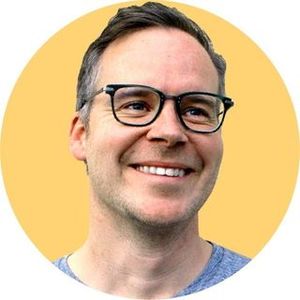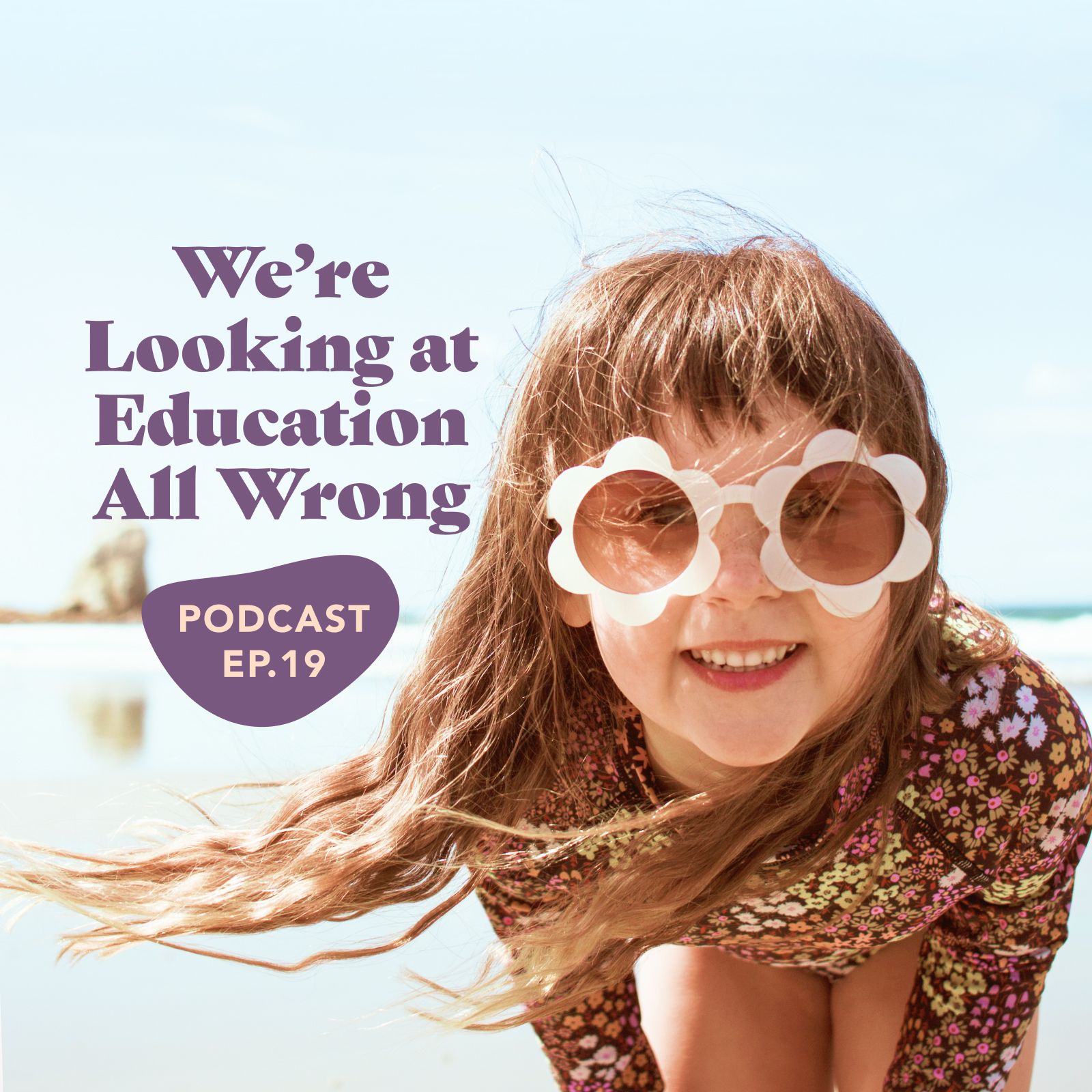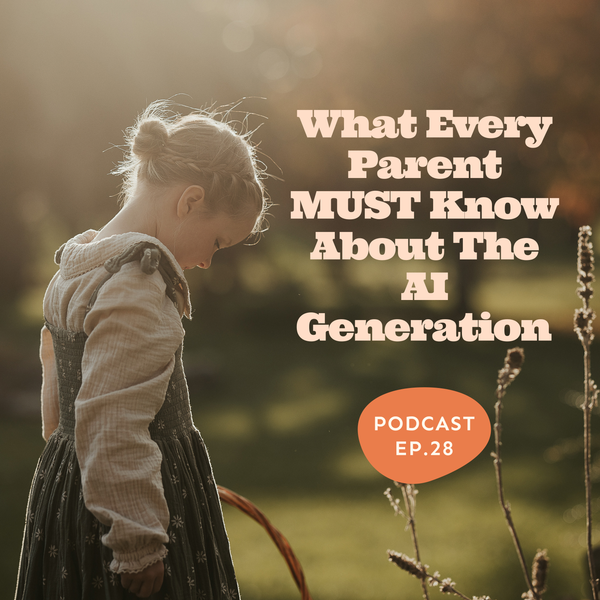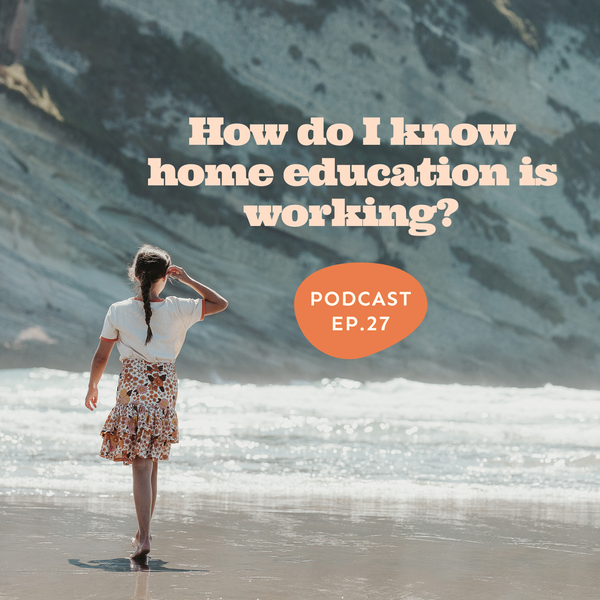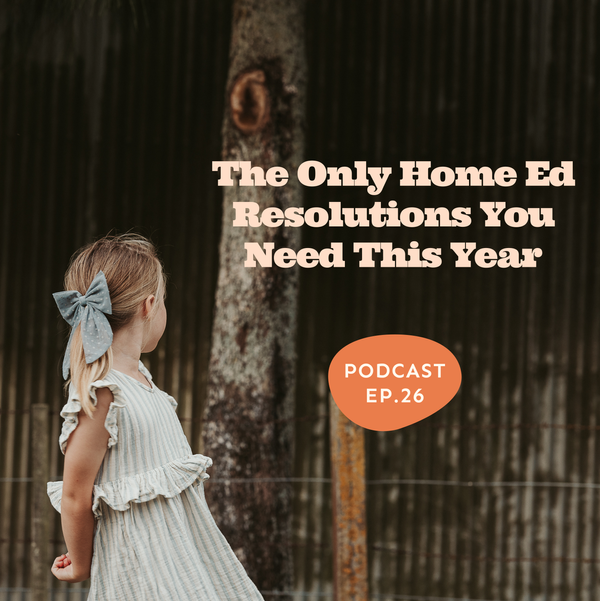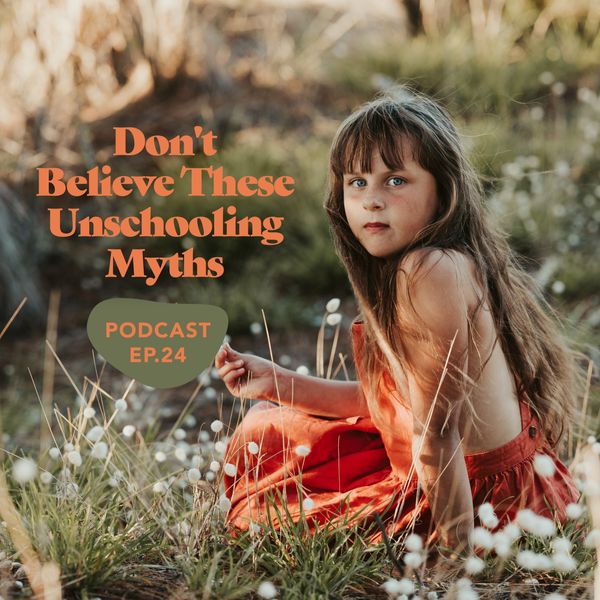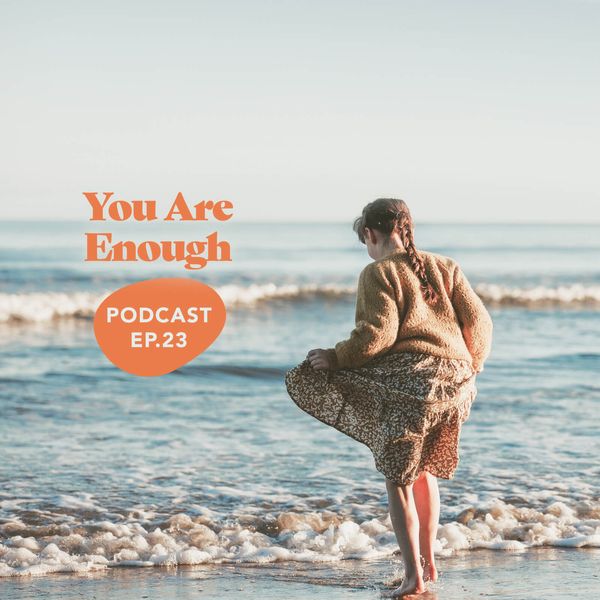The globally accepted definition of education is children being taught, and learning, in a classroom setting.
But is that interesting, and inspiring? Will it help our children become independent, life-long learners, and the best version of themselves?
Today, together, we’re going to give education a new definition. We’re going to take the entire concept, and look at it with fresh eyes.
It might be a bit surprising. And it will most definitely be enlightening.
These private episodes go even deeper, backed by research, the science of how children learn and grow, and more than a decade of lived home educating experience. Each one is designed to help you rethink, reframe, and recalibrate the way you're walking this path, giving you the confidence to live the version of life you want. The Collection is 23 episodes strong and counting, with over 10 hours of listening available right now.
As a subscriber, you'll also get immediate access to my self-paced course, expert-led masterclasses recordings, five downloadable guides, our school exemption documents, and more 💛
Complete Transcript
Helloooo and welcome to the Life Without School podcast, here to help you and your children live the life you want to, not just the one you’re told you should.
I’m Issy, a writer and home educating dad from New Zealand.
You can find my work at starkravingdadblog.com – all of my posts, podcast episodes, and short films created to encourage, support and reassure anyone walking this road less travelled.
Thank you so much for tuning in to listen today. Alright, let’s get into this week’s episode.
Hello there, it’s wonderful to have you tuning in today, so thank you for being here.
Today, you and I are going to do something interesting. We’re going to take education – what it traditionally has been defined as – and we’re going to make a change to it. We’re going to redefine the word. And then with that new definition in our hands, we’re going to go on a little journey through various areas of education and look at them with completely fresh eyes.
We’re going to come at the whole idea of education, and learning, and childhood, as fresh as we possibly can. And we’re going to see how important that starting definition is, and how quickly the new path we look at diverges from the traditional one.
Ok, let’s get into this conversation – one that is going to help us look at the whole educational landscape with fresh eyes.
We’ll start with the globally accepted, most common definition of education:
“The process of teaching or learning, especially in a school or college, or the knowledge that you get from this.”
Let’s grab a couple of sentences that we can use as a reference point for this, so we can swap in this definition, and then the new one that we’ll look at:
- We place great importance on education.
- And it is important for children to get a good education.
So using those, let’s now put our traditional definition in:
- We place great importance on the process of teaching and learning
- It is important for children to be taught and to learn.
Ok, that sounds about right, doesn’t it. That’s the general definition of education that most people would accept is correct, and right. No arguments there.
But…does it sound interesting to you? Do we think it sounds interesting to our children? “It is important for you to get a good education, young man. It is important for you to be taught, and to learn.” Ok….ummm…why? It’s never sounded very interesting or exciting to me, as a child or an adult.
So, let’s not use it. As home educators, we can – and should! – shake up any traditional ideas about education in favour of being more interesting wherever we possibly can.
Let’s find a different definition, but also, let’s not stop there. Once we’ve got it, we need to go and look at all the main areas of education through that new lens, from that new perspective, and see where we end up.
When I first looked up the definition of the word education, I spotted a term that actually does excite me. Today – and perhaps, if we like it, beyond – the word ‘education’ is going to mean ‘an enlightening experience’. This is an actual definition of education if you Google it. It’s just not the primary one, or the most commonly used.
But it’s fantastic, right? It’s actually what we’d all hope the experience of education would look like, and result in. Because the first definition is all about delivering something, and the process of ensuring the person on the other side of that is receiving it, and the second is more about a person discovering something they genuinely value. Something that genuinely helps them grow in some way.
So now let’s swap that definition into those two sentences and see how it sounds:
- We place great importance on enlightening experiences, or
- It is important for children to get enlightening experiences.
Yes, I like that.
Let’s make this our starting point today. We’ll take this different view, and we’ll use it as a lens to look at four key areas of education in a totally fresh way.
We’ll look at them not as we typically do, as that first definition does, but from that perspective of enlightenment. We’ll take away the formality, the expectations, the pre-conceptions…and look at all this like it’s new. Like, we’re coming at the whole idea of education for the very first time.
I think this is going to be fun. I think it’s going to be enlightening.
Let’s do this.
Part One: The content that makes up an education.
What content will we teach, and what will be learned vs What content will enlighten us
Ok, that’s a big shift. That first line is pretty accepted, and pretty removed from whoever it is that’s going to have to do the learning. Because in most educational settings, the person on the end of that has absolutely no say in the content. The content is set the same for everyone, and our only variable is the person on the other end of it. That’s really the only thing that ever changes.
But in that second line…there’s suddenly no emphasis on teaching and learning at all. The content suddenly becomes variable. It can’t possibly be the same for everyone, because everyone’s different. And so instead of focusing on that content, and what will be taught and learned, we focus on the learner.
And when we do that, it becomes clear that the information, and skills, and knowledge, and interests, and abilities that will make up a person’s learning journey must start with them. Must be unique to them. Must be less broad, but deeper. And it becomes clear that while introducing areas of content to that person will feel natural and important, delivering a blanket set of information broken into what are made to feel like individual subject areas would absolutely not.
Through the lens of needing to teach, and to ensure a standard set of learning, it’s easy to see why we’ve broken education down into buckets of subjects.
But through the lens of enlightenment, it feels crazy. The world around us is not neatly divided into subjects. It is not black and white, and compartmentalised.
Every concept, thing and person in this world is connected, related, intertwined, blended with something or someone else. To remove a piece of that, to silo a concept, to study it in isolation from what it naturally wants to connect with, does a disservice to both the thing itself and the studier of it. Important context sits outside that silo, context that will be completely missed. The learning becomes disconnected, and so the learner becomes disconnected. Not from the subject – they may even master it – but from how it connects and fits with the real world. It is learning, but it is not enlightenment.
Over time that learner accepts the compartmentalising. No, it’s more than that…they become comfortable with it. With black and white, right or wrong, pass or fail. They become less comfortable with deep dives that raise questions, and have no obvious end or answer. With failure, experiments, tangents. There is no time and space for any of that. And there is no incentive. We’re not trying to enlighten ourselves, we’re trying to learn what we’ve been asked to learn.
We’re trained – from so early on, now! – that education is about picking up enough detail to satisfy the expected requirements, and then moving on to the next one. Not stopping to dig deeper.
But the world is not black and white, right or wrong, pass or fail. It is a beautiful mystery that’s crying out for us to discover and explore its nuances. To understand its connectedness, with us and others, and learn from that in meaningful ways. To solve its complex problems.
And, to find our own sense of meaning and enlightenment within it.
If you want to look at education with fresh eyes – this is the most important place to start. With the idea that we know what every child should be learning, and that it is the same for everyone. That we have set subjects, and they do not change. Regardless of the child. That it is more important to cover a wide range of these things than it is to focus in and go deep on less.
But we have a new definition, now. We’re no longer focused purely on teaching and learning. Those things have their place, but only as they naturally happen, or are needed, in the search for enlightenment in a particular area. They just become another tool at our disposal.
Can you feel the balance of power between the educator, and the person being educated, shifting? I can. And, actually, it’s more than that. I can feel the very idea of power and hierarchy – things formal education are built on – completely eroding.
Because once we decide we won’t be telling a child exactly what they’ll be learning, and that a lot of that will come from within them, on their terms, allll that pressure and tension involved in trying to get them to learn this big stack of things just dissolves. And instead of feeling like you and your child are almost opposing forces in this, you suddenly feel like you’re on the same team. And, most importantly, they feel that.
They feel the focus of their childhood shift away from instruction and compliance, towards choice and meaning. From being told what they’re going to learn, whether they like it or not, to being asked what they might like to discover more of. It sounds simple, but I can promise you that from a child’s perspective it is mind blowingly profound and empowering.
They get to use, and build, and – in the case of children who have spent time not using it – repair, the muscle of drive. That internal motivation to explore, and discover, and question, and – ultimately – enlighten themselves.
Don’t ever let anyone tell you that children are not inherently driven to learn. They truly are. The problem is that when we package education, when we package learning, as a thing that is going to happen to them whether they’re interested or not…that drive starts to diminish. Of course it does. It just becomes overwhelmed by their need to manage and process and reconcile, internally, what is being asked of them.
We can’t expect our children to jump out of bed feeling deeply motivated every day if they’re just having educational content continually pushed at them. Just as we wouldn’t expect an adult to respond in motivated, self-led, self-driven ways if we told them exactly what they’d be learning, whether they like it or not.
If you want a child to develop their autonomy, and energy, and passion, and curiosity – all things that are naturally in them – then you need to start with choice. You need to tell them less, and listen more.
Take choice away, and those things will be buried deeper, and deeper. The more choice you offer in the content that forms your child’s educational journey – and then everything that follows that – the more they will need to access those internal qualities. The more they will need to use and develop those muscles.
And the stronger they will become.
Part Two: Delivering educational content
Right, with the kind of approach to content we’ve just discussed – what it could look like, and what it probably shouldn’t – let’s compare our definitions to work out how we’ll go about delivering it.
How will that content be taught and thus learned vs How will that content bring enlightenment
There are two aspects we should talk about here – the role of the person who facilitates the delivery of content in education – typically a teacher – and the structure, timing and flow of how all that happens.
So first, let’s look at the person in the key role here. Because we can’t have a fresh conversation about education, without also looking at the role of a teacher.
In formal education, a teacher’s role is to tell someone what they will be learning, and then set about ensuring that happens. Typically, there is no consultation in this process with the learner. There is, as we have just discussed, a pre-existing set of content that has already been decided on. That content – that educational package – is the starting point.
Now, that’s fine if you live in a world where that educational package is the most important thing. Where the teaching, and then the learning that must follow it, is agreed to, and set, and required.
But that doesn’t fit our new definition. Because if our goal is to help bring enlightenment to a child, then, obviously, any forceable teaching of things they’re not genuinely interested in right now will do the opposite. Literally. If you ever want to see a living example of the human brain going through the opposite experience of enlightenment, watch a child sit there being taught trigonometry when they have no interest in it, or any real understanding of what’s going on.
So what kind of teaching role does fit in this new world we’re defining? Well, we clearly shift from telling a child what, when and how they’ll be learning – whether they like it or not – to helping a child learn, and develop, and discover more deeply in areas they have chosen.
We shift to helping a child string together moments of enlightenment, that then lead to more moments of enlightenment. We shift to being deeply in tune to who the child is, and introducing areas of the world around us, and life, and ideas, and people, and resources who they don’t yet have an awareness of, but that we believe they will find interesting and useful. We ease back if we find we’re introducing those things at the wrong time, or in the wrong way, for that particular child. And we make sure we come back to those things in different ways, at different times.
I’ve spoken about this before – this is not a tenable approach to the role of teacher in formal education. It requires far too much focus on the individual child, and far too much time invested in that child. A teacher in a classroom has too much on their plate to do things this way. And, they’re also having to juggle the demands of their superiors – the curriculum, and the testing, and the results. It’s…too much.
But for you and I – for a home educating parent – this is a tenable approach. You don’t have to spend the first month of every new school year trying to work out who your children are because you already know them.
And while you might have certain requirements to meet as part of your home educating agreement – some parts of the world are stricter and more formal on this than others – you categorically have more freedom in your role than a teacher in a school. You have less children – far less children – to spread your focus across, and you have more time – honestly, so much more time – because you have none of the forced schedules and structure teachers have to run their days against.
In short – you have a huge head start, and a huge leg up. And that means you have the time and space to put enlightenment before teaching and learning.
I talk about this a lot, so bear with me as I say it again, but it’s so important – if we define education as the pursuit of enlightenment, then you are not your child’s teacher. You are their coach, and their guide, and their mentor, and their supporter. And, like I said in the first section, when you make that shift clear to your child the power struggles that so often exist in educational environments just wash away.
Now, I mentioned the word structure, and we need to dig into that. Because like I said, there are two key aspects to the how of an education. There’s how we’ll deliver it, and there’s how we’ll structure our days while we do that.
Clearly, when you decide that the primary goal is to deliver a very specific package of content, the most natural step that follows that is working out how much of that we’ll need to get through during the course of a year. Then a term. A month. A week. From there we can work out how much time we’ll need to spend on each area per day, and then – it’s simple – just divide the hours we have available across them.
We step back, we look at the schedule, and we smile. It all fits in. We have everything we need to cover in the year slotted into place.
It’s a lovely, ordered way of thinking about things. It’s efficient, and clean, and satisfying.
But, it also completely ignores the child. It completely ignores the fact that the human brain does not compartmentalise in this way. And it almost completely removes the opportunity for experiencing true enlightenment.
It becomes really obvious when we go back to our example sentence:
How will learning and teaching be scheduled and structured?
Well, that makes sense. But when we use our new definition, it completely falls apart:
How will enlightenment be scheduled and structured?
See? It can’t. That’s not how enlightenment works. It’s not how true, deep learning works. Because it’s not how our brains work.
The process of learning, and enlightenment, is far more fluid than that, far more organic.
Now, don’t get me wrong. Structure, in and of itself, is not a bad thing. I’m not saying we should never have structure and schedules in our life. In fact, they’re very useful, and at times very important.
I’ve talked about how my children and I do karate together. You won’t find many environments on the planet that are more structured, formal, and disciplined than a traditional karate dojo. And the same structure, and the same rules, apply to every single person that arrives at that door. Everyone operates under the same expectations, and the same schedule. If you do not, if you choose to do things your own way, you will be pulled up. You will face reprimand and correction. Verbally, and even physically – in the form of things like extra push ups or crunches. Often, while everyone else waits for you to complete them.
But the difference is that my children and I have chosen to submit ourselves to that structure. To that discipline. To that teaching. Because it is a necessary part of a journey we want to take. We want to develop as martial artists. We want to build better control over our bodies, and minds. And we trust that the sensei standing in front of us is going to help us do that. The structure, and the rules, and the discipline is not arbitrary. It is intentionally designed to bring the kind of progress and results that the students standing in that dojo are there for. It is there to bring them the kind of enlightenment they want to receive. And if they choose to leave, and never submit themselves to that again, they can. No one is requiring them to be there.
Structure. Discipline. Formality. These can all be wonderful things. They are not inherently bad. They can, and do, exist in the same space as enlightenment.
But if we take them, and start applying them to areas of life where the person on the receiving end has not explicitly chosen to submit themselves to them, for their own good reasons, they become suffocating.
Our starting point should be: intention. Our days don’t have to start with structure and schedules, they should start with whatever our children need to grow the parts of themselves they’re most excited to grow. And with our new role defined as a home educating parent, we can guide and help them on this. Maybe, their days will involve structure – but it’s your job to make sure that’s only happening because it’s needed. That it’s there to help your child, and who they are, and that it’s not just getting in the way.
When the goal is to achieve a specific level of learning in a clearly defined educational package, then you are going to have to schedule that into your days. But if your goal is to help your children find enlightenment, and to continue making new discoveries as they grow their awareness, and skills, then your days won’t need as much structure as you think.
What they’ll need – what you’ll all need – is whatever will help you get the best from yourselves.
Bring some fresh eyes to that, because you might be surprised by what you see.
Part three: Where education happens
We’ve talked about the content that makes up an education. And we’ve talked about how that will be structured – or not – and delivered. Now, with totally fresh eyes, we need to talk about where that will best happen. Let’s compare these sentences:
Where will teaching and learning best happen? vs Where will enlightenment best happen?
Oooo, this is interesting, right? Because I’m not sure how many of us would look back on our time in a classroom setting and say it was a space conducive to enlightenment.
I want a take you on a slight tangent into the tech startup world. This is something I do a bit, because, that world has been such a big part of my life for so many years, that it’s become a really useful frame of reference for me. So, stay with me, I promise this is incredibly relevant to what we’re talking about here.
It became very trendy a while back to have big open plan offices. Tech startups were leading the design of these new types of physical spaces, to try and give their teams better ways of working. In theory, it was a wonderful idea. You go from boxy little cubicles, where everyone is separated and isolated, and you bring them together. You design spaces where you’re surrounded by the people you need to communicate with to take projects forward, and if you can make communication flow better then everything else will flow better too. Thoughts, ideas, progress…
But what we learned – and, I’m talking from both a research perspective but also my own personal experience of setting up and trying to be productive in these kinds of spaces – is that it can be incredibly distracting to work in a room like that. You have a conversation between two people playing out at a table to your left, you have someone on a phone at a desk to your right, you have a group of people chatting on a couch behind you while they have a coffee…if you’re trying to go deep on something, it’s almost impossible. And you can’t just tell everyone to be quiet at certain times, and open and louder at other times, because we know that everyone does their best work in different times, and in different ways. You can’t just schedule everything.
Now, the tech world took a bit of time to start accepting that mayyyyybe it’s not the most ideal space for that deep, focused work. Because, it was trendy, it was cool, it was a great way of attracting top talent. But what became quite clear is that the space in which you do your best work is a very individual thing. There isn’t a global physical standard we can just pull out and apply to everyone.
So then came the next revolution in where we work, which was again led by tech companies. And that was this remote work concept. Doing what we do, but from our homes. From cafes, and libraries, and picnic tables at the park. It was this idea of opening up the entire world as a workspace, with the opportunity to pick and choose the physical environment that each of us best thrives in. Not just one, but even different environments on the same day.
Different places and spaces for different types of work, and people.
In a very early episode, I told the story of a company I joined, almost 10 years ago now, when remote working wasn’t a big thing. There were a few companies doing it, around the world, but it was still seen as a lesser option than having a big, fancy office space that was designed for – you know – work.
I vividly remember our CEO, a very dear, respected friend of mine now, being told in our early days that the remote working thing we had going on for our team of five was lovely, but…wouldn’t work when we started to grow. That, at some stage quite soon, we’d need to get our team into one physical space. When I left that company, over 100 people were waking up each day able to make the choice to work from their home, or a cafe, or one of the office spaces we’d set up to be used whenever and however they needed.
It turns out, it could work. And not just work, it was better. Research is starting to appear now that shows gains in both personal satisfaction and professional performance when you have choice in your working environment.
And speaking from my own experience, again, I am absolutely happier, and produce better work, when I have a say in the physical space I’m doing that in.
Now, obviously, not everyone can work remotely. Not every kind of job or career can be done from home or the park. But we’re not talking about jobs and careers here. We’re talking about childhood. We’re talking about education.
And those things dovetail beautifully with the concept of remote and flexible working. Especially when we think less about teaching and learning, and more about enlightenment.
Go back to what I was saying about these big, open workspaces that companies started using. Go back to what I was saying about the distractions, and noise, and continual interruptions and focus breakers. And now picture a classroom. One, open room, with 20 or 30 people in it. And actually, I hear these days that classroom walls are being knocked down to make the spaces – and groups within them – even bigger. I don’t know whether this is a delayed following of the open plan office space idea or not, but I know it’s not a good one. If it could be a space a child had access to as and when they wanted a bit of noise, and collaboration, and discussion, absolutely. But as your one and only workspace, for the entire day, every day? No way.
If we want to provide a physical space that gives the best possible chance for enlightenment, regularly, then we need to make sure it’s one the individual child actually thrives in. As home educators, we have that opportunity. We can create and provide access to different kinds of spaces, depending on who our children are and what they need from their days. We don’t need to restrict ourselves to that old definition, to what traditional learning and teaching spaces look like.
And none of that has to be fancy. Our children just need to be comfortable, and to have access to both quiet and then open, conversational environments as and when they need them.
In fact, if we really get down to it, we might be surprised by what research tells us the most ideal learning environment actually is. It’s one that many classroom designers have tried to emulate. It can be described like this:
Flexible, agile, inclusive spaces that provide different environments for different learning styles and personalities.
As little artificial lighting, and as much natural light, as possible.
Less clutter, and less loud, gaudy colours, which are both visually distracting and mentally fatiguing.
Open spaces that inspire and foster collaboration.
Dedicated quiet spaces for rest, reflection and decompression.
Better air quality, and more plants.
These are the key qualities we’re looking for, but it’s a bit odd to me, because…that’s nature. The ideal learning environment we’re trying to create…it’s nature.
Through fresh eyes, it’s clear that we overcomplicate learning spaces. It’s clear that we spend far too much time, energy and money trying to create these physical environments within which we can teach, and learn. But that’s no longer our definition.
We’re looking for enlightenment. We’re looking for places, and spaces, that will foster that process.
And you can find those in what you already have. A sunny spot on a bedroom floor. A cosy couch. The dining table, or a small desk in your room that’s just yours. Under a tree, in the breeze. Sitting in a museum, or a library. Walking through a park, or a forest, or alongside a stream.
Know this: one day we will look back in shock that we put children in classrooms and expected them to feel inspired. So please, don’t ever feel you need to re-create what you’ve seen there.
My guiding rule when it comes to this stuff? Trying to create a space in which the best learning will happen will just get in the way.
Keep it simple. It’s almost always the best.
Part Four: Measuring education
Obviously, this is critical to most educators. If we’re delivering a learning package, we need to know how effective we’re being. We need to know it’s being taken on board. But let’s compare our two definitions:
- Measuring teaching and learning, or
- Measuring enlightenment.
Well, that first one is easy. We do that all the time. We test, and we mark, and we grade, and we assess. And we do it because we have the same progress map for every single child. It makes sense.
But that second one. Measuring enlightenment. Well, just like the schedules and structures we talked about, the idea of measuring enlightenment just feels…jarring. It’s not a concept that really makes any sense at all.
If we move on from the idea that we have one set standard, and benchmark, for every child, then we need to move on from the idea that we need to measure, and assess, and compare. Because when enlightenment is the goal, it is quite obvious that that’s a deeply personal journey. That it will be different for everyone. That it will change, and evolve, and grow with each person as they seek it from their life.
It becomes something that we’re inherently aware of. It’s…within us. And the more we tune into that, the more our awareness of it grows. We feel it through things like happiness, and satisfaction, and meaning, and purpose, and service. And when we stray from living life in a way that grows those areas within us, we feel it. We know. We don’t need anyone to tell us.
I’m keeping this section on measurement brief, and that is very intentional. Because, as humans, we give far too much of our headspace, and lives, to being measured, and benchmarked, and compared. Even as adults. Maybe, even, especially as adults. And if we want to make sure our children can access a different version of life – one where the measures they live by are internal, and personal to them, rather than external, and put on them – then we need to start now.
Today.
Take away the benchmarks. Take away the comparisons. Take away the expectation that they will be at a certain level, by a certain age, in certain things. Because it strips us of the opportunity to develop our own real purpose in life.
Instead, help your child build on their inherent ability to feel. To be aware of their growth in life, and whether that’s tracking in a direction, and in ways, that they want it to.
Don’t push them to measure up to some arbitrary, global standard. Please. Just help them become the truest version of them.
Two definitions of education, that clearly lead down two very different life paths. One, a path that serves things that are completely external to ourselves. That serves the needs of a curriculum, and educators, and tests, and schedules, and benchmarks, and requirements.
And then…one that serves the human being that’s actually walking it. One that serves the needs of their life, and purpose, and talents, and interests, and skills, and motivations. One that will help that person get the most out of themselves, become the truest version of themselves, and one that will help them serve others in genuine ways, too.
These two versions of life are profoundly different. But they start with something very simple. The way we define education.
Is it teaching and learning, or is it enlightenment?
As a home educating parent, you will be the one deciding where the emphasis goes. So…choose carefully, wisely, and confidently.
Ok, we’ll call it there for today. If this episode has had an impact on you, please leave a review on your podcast platform of choice. It really does help more people find us here.
Thanks for listening in, and I’ll see you back here soon.
Bye for now.

